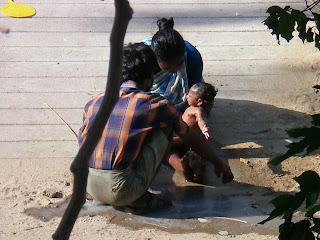Life is a journey to an unknown place . . . Through my journey along the path I met wonderful children, youths and adults who in turn teaches me to understand the meaning of life. In searching and discovering more about myself and find meaning to life I visited many places in different states in India and Nepal. This journey of life was exciting when I challenge my own weaknesses.
Tuesday, May 31, 2011
Ross Island - Port Blair
Ross Island -
Bearing a haunted look today, the Ross Island was the Administrative Headquarters for the Andaman and Nicobar Islands, before an earthquake rocked it in 1941. The headquarters were then shifted to Port Blair.
One can see remnants of an opulent past in the ruins of the church, swimming pool and the chief commissioner's residence with its huge gardens and grand ballrooms. There is also a cemetery and a small museum managed by the Indian Navy. The museum has on display a collection of old records.
The Ross Island is about 2 km east of Port Blair and can be reached by a short boat ride from Phoenix Bay Jetty. The island is controlled by the Indian navy, which requires every visitor to sign in on entering.
The small island with its treasure of ruins in it became the hot tourists spot in the territory. People desire to know more and more about Ross Island. This Island the erstwhile capital of Port Blair during the British regime, is a tiny island situated few Kilometers away from Port Blair city. The island presently houses the ruins of old buildings like Ballroom, Chief Commissioner’s House, Govt. House, Church, Hospital, Bakery, Press, Swimming Pool and Troop Barracks, all in dilapidated condition, reminiscent of the old British regime. Ever since Dr. James Pattison Walker arrived in Port Blair aboard the East India Company’s steam frigate ‘Senuramis’ on 10 March 1858, this island remained under British occupation till 1942. From 1942 to 1945, the island was under the occupation of Japanese. However, the allies reoccupied the island in 1945 and later abandoned it. During British occupation, this island was the seat of power of the British.
Port Blair - Andaman & Nicobar Islands
Leaving Port Blair for Little Andaman (Hut Bay)
Some interesting facts about these islands
- Location: They are located off the eastern coast of India and politically they are a Union Territory of India.
- Population: 3,60,000 ( Prior to the tsunami as per the 2001 census)
- Area: 8248 sq. km (with the Andaman islands having the largest proportion of the total area covered by the 500 islands)
- Capital: Port Blair
- Main languages spoken: Hindi, Tamil, Telegu, Bengali and various other tribal languages and dialects.
How did these islands get their name?
Haddow Jetty - Port Blair
Haddo jetty that connects to different islands.
My first stop before embarking on the journey into different parts of Andaman and Nicobar Islands was Port Blair. It takes two – three days to travel by ship to Campbell Bay (Great Nicobar), one and half days to Car Nicobar and eight to twelve hours to Hut Bay (Little Andaman) from Port Blair.
Bird Eye's View - Andaman & Nicobar Islands
Before landing in Port Blair photo taken from Jet Airways.
This is the first time I travel to these islands after the Tsunami to work for the children affected by the Tsunami.
What makes these islands unique?
Monday, May 30, 2011
Friday, May 27, 2011
Onge Tribe - Little Andaman (Hutbay) - Andaman & Nicobar Islands
They are not NEGROES but Indians.
On my way to Little Andaman (Hutbay) by ship I met the Onge tribe on board.
Together from Port Blair we traveled for almost 12 hours to reach Hutbay.
Who were the original inhabitants of these islands?
Subscribe to:
Comments (Atom)
















